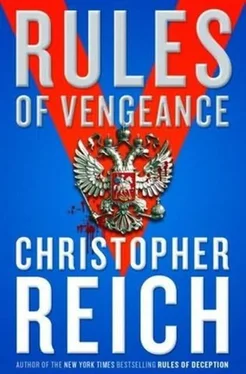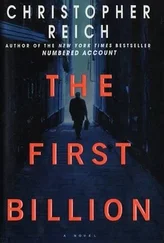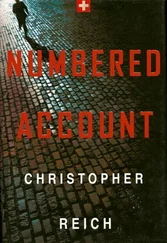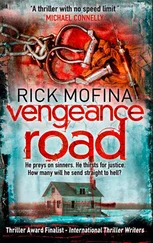“And what did he want to know?”
“Nothing. Actually, he gave me a bit of information. He told me that there might be a new field worth exploring in the North Sea. He didn’t tell me how he knew, just that it might be worth our while to stake a claim to a certain quadrant in international waters.”
“And was it?”
“Do you mean was there oil there? Quite a bit. But at the time oil was going for forty dollars a barrel. At that price, it was too cheap to be extracted profitably from such a difficult spot. The boys in exploration didn’t want to touch it.”
“But the price went up,” said Kate.
Bella smiled knowingly. “That’s why BP has a rig up and running on those exact coordinates.”
“That’s some information,” said Graves.
“Five billion euros’ worth.”
He whistled under his breath. “And so?”
“And so,” Bella continued, “when Robbie asked for my help, I gave it.”
Graves crossed his arms, assuming the inquisitor’s stance. “What exactly did he want to know?”
“He wanted me to put him in touch with some of my contacts at the IAEA,” responded Bella Lauren, answering his stare with one of her own. “I left BP years back. I design nuclear plants now. He said he had information for them.”
“What kind?”
“He was worried about an accident at a power plant. A nuclear plant. He wasn’t specific as to what kind of accident or where, but he seemed to believe that something might happen soon.”
“In your message you said, ‘Seven days isn’t long enough for them to unpack their bags,’” said Kate, hoping to prod her. “That soon?”
Bella nodded. “It’s scary, I know. He asked me lots of questions about security measures and that kind of thing. I put two and two together. If Robbie wanted to talk to the IAEA about a possible ‘accident,’ and he was interested in how well or poorly guarded the plants were, then I just assumed he had wind of something bad. I mean glow-in-the-dark, hair-falling-out-of-your-scalp-in-handfuls bad.”
“So you put him in contact with the IAEA?”
“Yes.”
Kate consulted her notepad. “You also asked him if you needed to leave. Did he ever indicate that the ‘accident’ might occur on British soil?”
“Never. I can’t think it was, or he would have warned me.”
“Can we talk about Mischa?” inquired Graves. “What exactly does she do for the IAEA?”
“She’s director of S &S at their headquarters in Vienna. That’s the Department of Nuclear Safety and Security. She’d come to London to meet with the UK Safeguards Office. They help manage security protocols for the EU.”
Graves exhaled loudly, then turned away and planted himself by the window, where he stood gazing at the sea. “Safety and Security,” he said, his voice wrung out. “They’re the IAEA’s watchdogs.”
“What do they do?” asked Kate.
“A lot of things,” said Bella. “They set up procedures for safeguarding plants, of course. Handle vetting of employees. Standardize training of plant workers.”
“And watch over the illegal trafficking of radioactive materials,” added Graves from across the room. “It’s up to them to make sure that no one is selling weapons-grade uranium on the black market.”
“Is that what you think Russell was worried about?” asked Kate. “A weapon?”
“If it were a weapon, Robbie would have gone directly to the police. I know that much. This was different.”
“How?”
“He was primarily interested in learning how people got into and out of the plants. Who was granted admission, who wasn’t. If all vehicles were searched. If the plants maintained paramilitary forces to protect them. I couldn’t answer half of his questions. He was upset that he wasn’t able to figure things out. That’s why he was so desperate to speak with Mischa Dibner.”
Graves crossed the room and sat down facing Bella Lauren. “But how did Russell come to suspect an attack in the first place?”
“It’s what he did. He gathered information.”
“Yes, but from whom?” asked Graves.
“Who told him about Victoria Bear?” pressed Kate.
Bella Lauren looked up. “I don’t know, and I knew better than to ask. All Robbie said was that he’d been asking questions where questions weren’t appreciated. He told me not to worry. He said he’d done everything he could to make sure he was safe, but with these people there was always some danger.”
“Just who in the world are ‘these people’?” demanded Graves.
“I don’t know,” said Bella, looking into her lap. “But whoever they are, they killed him.”
Den Baxter’s day was picking up .
At 9 a.m. a section of the axle bearing the vehicle identification number of the BMW housing the explosives was found. The VIN was sent to BMW Headquarters in Munich, Germany, together with a second, different, and presumably false VIN recovered from the engine block the night before, to determine where and when the car had been manufactured and sold. Both numbers were also forwarded to Interpol headquarters in Luxembourg to be checked against a registry of stolen vehicles worldwide.
At ten, the Laser Transit Surveying team completed their initial mapping of the crime scene. Using an electrodigital theodolite, a telescope mounted within two perpendicular axes-the horizontal, or trunnion, axis and the vertical axis-the team plotted the grid points of all evidence, creating a three-dimensional picture of the crime scene. Among other things, the electrodigital theodolite measured the volume of the bomb crater, compared it to the distance and location of the blast debris (including the scattered remains of body parts), and determined the weight and distribution of explosives used in the device.
Initial measurements indicated that 20 kilos of plastic explosives had been packed into the BMW and that a significant amount of unmixed cement used as a tamping agent had ensured that the charge was directed into the passing vehicle. Conclusion: the device was hand-tailored to destroy a specific target while causing limited collateral damage. As such, Baxter could assume with a high degree of certainty that the bomb maker had at some point received an advanced course in military explosives training.
At eleven, Interpol called back to report that the BMW had been reported stolen from Perugia, Italy, three months earlier. From Italy, the car had been shipped to Marseille before entering the United Kingdom in Portsmouth. It was the firm of Barton and Battle LLC, registered automobile importers, that had cleared the stolen vehicle two weeks before and released it to the custody of a Mrs. K. O’Hara, resident of Manchester.
And at twelve, Baxter received a call on his two-way radio that would significantly alter the pace and direction of the investigation.
“Boss, this is Mac. Have a minute?” Alastair McKenzie was one of his up-and-coming stars, a twenty-four-year-old bloodhound with glasses like Coke bottles and intuition that couldn’t be taught. “I found a little something at the site.”
“But we already covered the crater,” said Baxter, playing devil’s advocate. “We didn’t find spit.”
“I decided to have another look anyway,” said McKenzie. “Thought I’d give the Microviper a go.”
“Of course you did, lad. That’s why I love you. Stay put. I’ll be right there.”
Baxter dumped his piss-warm coffee into the trash and hurried down the street. He found McKenzie standing waist-deep in the blast crater. In his hand, the gangly policeman held a metallic cable running to an aluminum suitcase that sat open at his feet. At one end of the cable was a miniature camera that broadcast its images on a high-contrast screen set inside the suitcase. The device was called a Microviper, and was in fact a portable, nearly indestructible microscope capable of magnifying images up to 1000X.
Читать дальше












